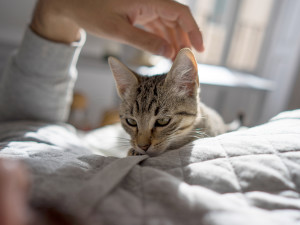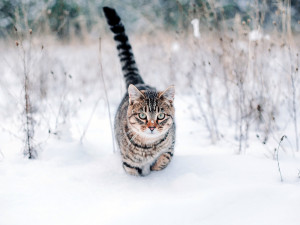How Cold Can Your Cat Handle? Learn How to Keep Them Warm and Safe
Just because you can withstand the temps doesn’t mean they can.

Share Article
In This Article:
Do Cats Get Cold? How to Tell if Your Cat Is Cold What Temperature Is Too Cold? How Do Cats Thermoregulate? How to Keep Cats Warm in the Winter Which Cats Tolerate Cold Weather the Best? How Do Strays Survive the Winter? What Temperature Is Unsafe for Cats?
Cats are connoisseurs of comfort. You may notice that your cat is most comfortable when curled up in a cozy bed or camped out in front of the heater. During the winter, you may also find yourself jockeying with your cat for a prime position under a thick blanket. That’s because cats tend to like things on the warmer side, leading you to wonder how much cold your cat can handle. We’ll help you figure out when your cat is cold and give you tips on keeping them warm and snug.
Main takeaways
A cat’s normal body temperature is around 100 to 102 degrees Fahrenheit, slightly warmer than a human.
You can tell your cat is cold if they are shivering, curled up tight, or unwilling to move around much.
The temperature at which your cat gets cold will depend on several factors including hair coat, health status, and acclimation.
Help keep your kitty warm by providing shelter, warm bedding, and possibly extra calories.
Do cats get cold?
Cats are warm-blooded animals, which means they need to maintain a constant body temperature for things to work right. They can’t let their internal temperature rise and fall with the environment the way a lizard or snake can. That means that if the temperatures around them drop, they will have to ramp up their internal heaters or seek warmth elsewhere, otherwise they can get cold.
You may notice that your cat burrows into blankets sooner than you do. That’s because they normally have a higher body temperature than us. It’s actually about two degrees higher, with cats hanging around the 100 to 102 degrees Fahrenheit mark and humans coming in at 98 degrees Fahrenheit. So, what may seem like a comfortable temperature for your body may be a tad on the cold side for your cat.

How can you tell if your cat is cold?
Watching cartoons as kids (or adults) taught us that when animals are cold, they stand with their teeth chattering, legs wrapped around them, and noses turning blue — while staring longingly into a house’s window. But actually, when a cat is cold, it’s not always that obvious. Instead, you’ll want to watch for these signs:
Shivering
Curled up in a tight ball
Unwilling to move
Seeking warm spots
Ears and/or paws are cold to the touch
If you notice any of these signs, it’s time to take action to get your kitty warmed up.
What temperature is too cold for cats?
Many variables play a role in the temperatures that are too cold for cats to tolerate. The same is true for a dog’s cold tolerance — so if you have a multispecies household, these variables apply across the board.
Your cat’s coat length and thickness make a huge difference. The thicker it is, the better a cat will be insulated against the cold.
Health conditions such as heart disease, diabetes, and kidney disease can make it more difficult for a cat to regulate their body temperature, so they’re going to prefer things a little warmer.
Generally, the more active a kitty, the more cold they can handle. And the more fat a cat has, the more they can withstand a temperature drop.
Acclimation is another factor. Cats who spend time outdoors, or solely live outdoors, will tolerate lower temperatures better than indoor-only felines.
With all these factors in mind, if you still need a number, focus on 45 degrees Fahrenheit. When it’s this cold outside, your mostly indoor kitty will likely need to stay inside, while outdoor cats will need an insulated shelter. For indoor-only cats, keeping temperatures above 50 degrees Fahrenheit is best, but your cat will likely be more comfortable between 70 to 80 degrees Fahrenheit.
How do cats thermoregulate?
Cats like to maintain a fairly constant internal temperature, which can be difficult to achieve in extreme weather. You may be more familiar with a cat’s cooling mechanisms rather than their heating system. Actions such as panting, sweating, and seeking shade help dissipate heat — while conserving heat works in the opposite direction.
To warm their body, a cat may shiver, which generates heat from muscle movement. They may also curl into a tight ball, particularly to protect their extremities (like their legs and tail) to decrease surface area and heat loss. They can also fluff out their hair, turning themselves into a puff ball which helps trap warm air against the skin. Their blood vessels near the skin constrict, or get smaller, to decrease the amount of heat lost. And of course, they seek out shelter and warm areas.
How to keep cats warm in the winter
A cat has many built-in mechanisms to help them either generate or conserve heat to stay warm when environmental temperatures are cold. But that doesn’t mean you can’t play a very important role in helping keep your cat warm.
Provide them with shelter. For indoor cats, this means an area of your home with a cozy bed, potentially in front of a heat source. Outdoor cats should have an enclosed area where they can get out of the wind and precipitation. Depending on how cold it is, insulation or a safe heat source may be necessary. Also, give them warm bedding.
Provide them with plenty of fresh water. Both indoor and outdoor cats need constant access to fresh water, because being hydrated plays a huge role in regulating their body temperatures. Outdoor kitties may need a heated water source to keep them from freezing.
Outdoor cats might also need a nutritional boost. Keeping warm burns a lot of calories, so giving your kitty something extra to nibble on can help them maintain a healthy weight and a healthy temperature. Feeding them kitten food could be a good option for providing a calorically dense diet to keep them warm.
Which cats tolerate cold weather the best?
There are always a few tough kitties in the bunch who seem to handle cold better than others, and there are always some who prefer a tropical vacation over a winter wonderland. But even with individual differences, some breeds are better equipped to tolerate the cold. This is typically because they have a thicker coat or were developed in colder climates. Those breeds include:
Maine Coon
Norwegian Forest Cat
Russian Blue
Turkish Angora
Scottish Fold
These cats may handle cold weather better, but you should not automatically assume they will be OK and put them outside.
How do stray cats survive the winter?
Stray cats are survivors, plain and simple. They find food, water, and shelter — but winter can still be tough without a human looking out for them. Stray cats often hole up inside vacant buildings or under porches where they can get out of the wind and weather. They may congregate together to share warmth and will typically spend less time moving about.
Most strays will try to bulk up their fat to keep themselves warm — and to provide energy for generating heat — during colder months. Stray cats may seek the warmth of your car, so be sure to check underneath and around it before venturing out in the wintertime.
What temperature is unsafe for cats?
This is going to depend on the cat, but as a general rule, anything below 45 degrees Fahrenheit will cause your cat some trouble without an outdoor shelter. When you factor in rain or wind (which contribute to wind chill), that temperature will feel colder than it is, so you can’t always rely on a thermometer. Instead, you’ll want to judge your cat’s reaction to the cold. If they are shivering or curling up, they’re cold and should be brought inside or into a shelter.
Of course, as temps get closer to freezing, fresh water becomes more of a problem alongside keeping themselves warm. It’s best to provide outdoor cats with a heated dish or refill water bowls throughout the day and make sure they have a cozy shelter, potentially with a heat source.
Prolonged cold exposure without some aid can lead to hypothermiaopens in new tab or frostbite, two potentially serious issues that require a vet visit.
Bottom line
In general, cats do not enjoy cold weather. Instead, they’ll seek out sources of heat and snuggle deeper in blankets to maintain normal body temperatures. If you have an outdoor cat, or one who goes outside during colder temps, be sure they have a cozy shelter out of the wind and precipitation, and give them a source of water that won’t freeze. If it’s below 45 degrees Fahrenheit outside, consider keeping your kitty inside or shortening their outdoor time so that they don’t get too cold.
References
“Can Cats Get Hypothermia? Signs, Symptoms and More.” Bond Vet. 3 Nov 2022. https://bondvet.com/b/can-cats-get-hypothermia-signs-symptoms-and-moreopens in new tab.
“Cold Weather Animal Safety.” American Veterinary Medical Association. https://www.avma.org/resources-tools/pet-owners/petcare/cold-weather-animal-safetyopens in new tab.

Dr. Chyrle Bonk, DVM
Dr. Chyrle Bonk has been a mixed-animal veterinarian since 2010, with a special interest in rehabilitation. When she's not practicing or writing about veterinary medicine, you may find her exploring the outdoors with her family or tending to her cows, horses, chickens, or cats and dogs.
Related articles
![Grey Scottish fold cat takes a bath with his owner.]()
How to Give Your Cat a Bath
Pro tip: Take things step by step.
![Woman feeding her kitten from a bowl at home.]()
What Is the Best Feeding Schedule for Cats?
Some helpful guidelines to follow.
![woman with dark hair lying in bed with striped cat, both asleep]()
Should I Let My Cat Sleep With Me? Things to Consider About Having Your Cat in Bed
Here are the pros and cons of having a feline sleeping buddy.
Why Does My Cat Sleep at My Feet?
Other than the fact that they love you so very much.






